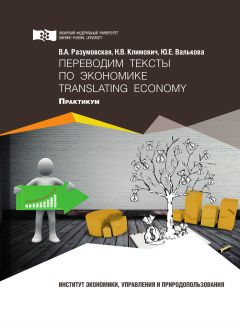Текст книги "Переводим тексты по экономике = Translating Economy"

Автор книги: Вероника Разумовская
Жанр: Прочая образовательная литература, Наука и Образование
сообщить о неприемлемом содержимом
Текущая страница: 3 (всего у книги 10 страниц) [доступный отрывок для чтения: 3 страниц]
Unit 2
Warming Up Activity
1. Translate the dates from Russian into English:
18 апреля 1830 г., 31 декабря 2016 г., 5 октября 1986 г., 27 июля 2005 г., 15 марта 2045 г., 22 ноября 1876 г., 1 мая 20017 г., 27 сентября 1978 г., 24 января 1657 г., 14 февраля 2000 г., 6 августа 1305 г., 15 декабря 2015 г.
2. Say the time in English:
19.40, 18.25, 17.35, 19.45, 18.10, 13.56, 06.15, 23.17, 20.30, 00.12, 15.55, 17.10, 22.46, 16.18, 19.15, 14.35, 11.45, 16.00, 20.01, 18.19, 01.35, 03.10.
3. Say figures in words:
34 567; 678 556; 987; 789. 008; 4 678 098; 0,5432; 8.006; 11 034; 145, 076543; 420 160; 0,810; 905 029 491; 831 830; 56.042; 14 074; 10 894.
Reading
4. Read the text.
Factors Influencing Pricing Strategy in International Marketing
By Smriti Chand
Some of the most important factors influencing pricing strategy in international marketing are as follows:
Pricing decisions are complex in international marketing. A firm may have to follow different pricing strategies in different markets. Whatever might be the strategy followed, pricing has to reflect the proper value in the eyes of the consumer. Pricing is an important strategic and tactical competitive weapon that can be used by a firm in international marketing.
It represents that element of the marketing mix, which is controllable by the firm to a large extent. A firm should integrate pricing strategies with the other elements of the international marketing mix.
Choice of a pricing strategy is dependent on:
1) Corporate goals and objectives
2) Customer characteristics
3) Intensity of inter-firm rivalry
4) Phase of the product life cycle
Having considered the factors influencing the choice of strategy, let us now turn specifically to different strategies:
1) Skimming Strategies: one of the most commonly discussed strategies is the skimming strategy. This strategy refers to the firm’s desire to skim the market, by selling at a premium price. Skimming refers to the objective of achieving highest possible contribution in a short time. To use this approach, the product has to be unique and the target market should be willing to pay the high price. Success of this strategy depends on the ability and speed of competitive reaction. A firm with a small market share can face aggressive local competition when using skimming. Maintenance of high quality requires lot of resources. If the product is sold cheaply at home, then the problems of gray market can surface.
This strategy delivers results in the following situations:
i) When the target market associates quality of the product with its price, and high price is perceived to mean high quality of the product.
ii) When the customer is aware and is willing to buy the product at a higher price just to be an opinion leader.
iii) When the product is perceived as enhancing the customer’s status in society.
iv) When competition is non-existent or the threat from potential competition exists in the industry because of low entry and exist barriers.
v) When the product represents significant technological breakthroughs and is perceived as a ‘high technology’ product.
In adopting the skimming strategy the firm’s objective is to achieve an early break-even point and to maximize profits in a shorter time span or seek profits from a niche.
2) Penetration Pricing Strategies: as opposed to the skimming strategy, the objective of penetration price strategy is to gain a foothold in a highly competitive market. The objective of this strategy is market share or market penetration. Here, the firm prices its product lower than the others do in competition. Penetration pricing uses deliberate low prices to stimulate market growth and capture market share. It can be useful when there is a mass market and price sensitive customers. Japanese companies increasingly resort to penetrative pricing due to intense local competition.
This strategy delivers results in the following situations:
i) When the size of the market is large and it is a growing market.
ii) When customer loyalty is not high customers have been buying the existing brands more because of habit rather than any specific preferences for it.
iii) When the market is characterized by intensive competition.
iv) When the firm uses it as an entry strategy.
v) Where price-quality association is weak.
3) Differential Pricing Strategies: this strategy involves a firm differentiating its price across different market segments. The assumption in this strategy is that different market segments do not communicate or have different search costs and value perceptions of the product. In other words heterogeneity in the market motivates a firm to adopt this strategy.
4) Geographic Pricing Strategies: this strategy seeks to exploit economies of scale by pricing the product below the competitor’s in one market and adopting a penetration strategy in the other. The former is termed as second market discounting. This second market discounting is a part of the differential pricing strategy where the firm either dumps or sells below its cost in the market to utilize its existing surplus capacity. So, in geographic pricing strategy, a firm may charge a premium in one market, penetration price in another market and a discounted price in the third.
5) Product Line Pricing Strategies: these are a set of price strategies, which a multi-product firm can usefully adopt. An important fact to be noted is that these products have to be related, in other words belonging to the same product family. Faced with multi-products and fluctuating demand, the firm may adopt a combination of the following strategies to effectively manage its product line or maximize its profits across the product line.
i) Price Bundling: this strategy is used by a firm to even out the demand for its product. This is useful strategy for perishable; time-bound products like food, hotel room or a seat on a flight and for products cannot be substituted, like the package of stereo music system. Off-season discounts and, season tickets for music festivals are examples of price bundling strategy. This is a passive strategy aimed at correctly bundling the prices of related items so that the firm is able to maximize its profits.
ii) Premium Pricing: this strategy is used by a firm that has heterogeneity of demand for substitute products with joint economies of scale. Consider the example of a colour television set. There are different models available with different features, like the one with a remote control and another without it. Both are substitutable and satisfy the customer needs. But the firm may opt to premium price the first model and position it as the top of the product line for high income or upper income group of customers or for whom communicating that “they have arrived” is important.
iii) Image Pricing: this strategy is used when consumers infer quality from the prices of substitute models or competing products. The firm varies its prices over different brands of the same product line. This strategy is commonly used in textiles, cosmetics, toilet soaps and perfumes.
iv) Complementary Pricing: this strategy is used by a firm that has customers with high transaction costs for one or more of its products. Transaction costs are all those costs that a customer has to incur to buy the product, like the registration fees that a flat buyer has to pay in order to be a legal owner or the processing fees that the bank may charge to give a credit card to the customer.
v) Captive Pricing Strategy: here a special price deal is offered to loyal customers or those who are regularly buying one of the products of the firm. A typical example is the Gillette shaving system, which offers two twin blades free with its razor to induce the buyer to purchase its blades. Kodak adopted this strategy, when it offered a film roll free to all buyers who bought its camera. As may be observed this is a strategy aimed at building customer loyalty.
vi) Loss Leader Strategy: this is another example of complementary pricing strategy. This strategy involves dropping the price on a well-known brand to generate demand or traffic at the retail outlet.
vii) Two-Part Pricing: this strategy is used by products that can be divided into two distinct parts. For example, membership of a video library has two parts – one is the membership fee, which is annual and the other is rent for each time frame for which a videocassette is rented. As may be observed the price has two components, the fixed fees and the variables usage fees.
From:
http://www.yourarticlelibrary.com/marketing/factors-influencing-pricing-strategy-in-international-marketing/5800/
5. Explain (in the original language) the following words and expressions from the text:

6. Give a written translation of the text (or some part of it – in accordance with the teacher’s task) into Russian.
7. Work in the group of three. “Back– translate” orally your Russian translation of the text into English.
8. Find Russian equivalents to the following words and expressions:
Adj.+ price: exorbitant price, prohibitive price, steep price, bargain price, asking price, cost price, purchase price, admission price, commodity price.
Verb + price: command price, fetch price, push up price, go for price, slash price, mark down price, undercut price, quote sb. price, bring down price, range in price.
Price + verb: price soars, price skyrockets, price slumps.
Price + noun: price level, price range, price cut, price war, price tag, price list, price index.
9. Give a written translation of the following extracts from Russian into English:
1. Теневые цены, как полагают создатели экономических моделей, следовало бы установить в случае, когда потребители и производители могут учесть внешние издержки и соответствующую прибыль. По системе учета национального дохода рыночные цены – это цены, которые платит потребитель. Цены производителей, равные рыночным ценам минус косвенные налоги и плюс субсидии, соответствуют прямым издержкам.
2. С точки зрения покупателя, цена является мерой, определяющей интенсивность потребности, которую он может удовлетворить, приобретая данный товар. При этом в процессе ценообразования следует учитывать, что покупателя интересует не только и не столько розничная цена, сколько цена потребления – суммарные затраты на приобретение и использование товара с учетом длительности его использования.
3. Решения, принимаемые руководством фирмы в области ценообразования, относятся к наиболее сложным и ответственным, поскольку они способны не просто ухудшить показатели финансово-хозяйственной деятельности, но и привести предприятие к банкротству. Кроме этого ценовые решения могут иметь долговременные последствия для потребителей, дилеров, конкурентов, многие из которых сложно предвидеть и, соответственно, оперативно предотвратить нежелательные тенденции после их проявления.
4. Установление цен в условиях рынка состоит из нахождения такой цены, которая представляла бы собой оптимальный баланс между суммой, которую желал бы заплатить за товар покупатель, и затратами предприятия при его производстве. В процессе установления цены значение затрат не должно превышаться. Затратные методы, которые основаны на ориентации цены на издержки производства, являются одними из наиболее распространенных в ценообразовании. В общем виде их суть состоит в том, что к рассчитанной себестоимости единицы продукции добавляются фиксированный размер прибыли и косвенные налоги.
5. Теоретическая основа калькуляции себестоимости с полным распределением затрат (Absorption Costing, тотальный подход) предполагает, что в соответствии с этой концепцией в себестоимость включаются все производственные затраты вне зависимости от того, постоянные они или переменные, полупеременные или условно-переменные. В любом случае условно все бухгалтерские затраты можно разделить на постоянные и переменные.
Unit 3
Warming Up Activity
1. Translate the dates from Russian into English:
26 мая 1940 г., 28 февраля 2002 г., 13 сентября 1994 г., 19 апреля 1365 г., 10 июля 1998 г., 30 марта 2008 г., 11 ноября 2021 г., 1 января 2011г., 14 апреля 2017 г., 29 октября 2024 г., 12 июня 1936 г., 27 августа 2016 г.
2. Say the time in English:
03.26, 19.38, 18.40, 23.45, 16.20, 13.30, 15.05, 20.50, 12.25, 00.13, 14.00, 20.11, 17.19, 06.30, 07.40, 22.10, 21.58, 11.43, 19.41, 11.30, 02.03, 12.40.
3. Say figures in words:
0,9834; 91 305; 102 946; 4 012 417; 148 916; 146.062; 598 710; 94.86534; 201 408,725; 50 368 295; 1 033; 16 430,3049; 0,2712; 303 323 014; 935 374; 342.
Reading
4. Read the text.
Мировой рынок
Мировой рынок – составная часть всемирного хозяйства, представляющая сферу спроса и предложения, а также коммерческого обмена товаров и услуг; система устойчивых товарно-денежных отношений между государствами, предпринимателями, коммерческими организациями, фирмами разных государств, связанными между собой участием в международном разделении труда.
В условиях глобализации, расширения и углубления мировых хозяйственных связей товарные рынки утрачивают национальные и территориальные границы, превращаясь в мировые товарные рынки, на которые выступают торговцы всех стран.
Мировой рынок представлен различными видами товарных рынков, рынков услуг, финансовых рынков, рынков ресурсов, в том числе и трудовых. Деятельность мировых рынков товаров и услуг регулируется международными товарными соглашениями. На каждом товарном рынке складываются свои центры торговли – «основные рынки», цены которых признаются базисными в торговле соответствующими товарами.
По способу организации торговли различают особые виды рынков: товарные биржи, аукционы, торги, международные выставки и ярмарки.
Мировой финансовый рынок
В последние годы наблюдается существенное возрастание масштабов мирового финансового рынка. Если ранее мировой финансовый рынок традиционно считали входящим в структуру мирового рынка ссудных капиталов, то в настоящее время граница между ними становится менее отчетливой и строгой, поскольку торговля финансовыми, а также производными финансовыми инструментами не может в полной мере быть подведена под категорию ссудного капитала.
Ссудный капитал, имея денежную форму, отличается не только от функционирующего капитала, но и от денег. Качественное различие определяется тем, что ссудный капитал – это одна из форм самовозрастающей стоимости; деньги, будучи особым товаром, играющим роль всеобщего эквивалента, сами по себе не дают прироста стоимости. Количественное различие состоит в том, что масса ссудных капиталов превышает количество денег в обращении, так как одна и та же денежная единица может многократно выступать как ссудный капитал.
Например, в США в 1975 г. сумма государственной и частной задолженности, которая условно принимается за величину ссудного капитала, составила 3 триллиона долл., а денежная масса достигла 301,6 млрд долларов. Таким образом, главной чертой ссудного капитала как экономической категории является передача стоимости во временное пользование с целью реализации его специфического качества – способности приносить прибыль в виде процента.
Под финансовыми инструментами понимается любой документ, специальным образом письменно оформленный в соответствии с нормативными требованиями (или как устно выраженное и впоследствии подтвержденное различными телекоммуникационными средствами обязательство), обеспечивающий их владельцу определенные имущественные права. Зарубежные экономисты делят мировой финансовый рынок на денежные рынки и рынки капитала исходя из критерия срочности инструментов этих рынков. Это позволяет говорить о мировом финансовом рынке как совокупности национальных и мировых рынков, обеспечивающих направление, аккумуляцию и перераспределение денежных капиталов между субъектами рынка посредством банковских и иных финансовых учреждений в целях воспроизводства и достижения нормального соотношения между спросом и предложением на капитал. С экономической точки зрения мировой финансовый рынок представляет собой систему отношений и механизм сбора и перераспределения на конкурентной основе кредитных ресурсов между странами, регионами, отраслями, экономическими агентами.
Мировой финансовый рынок аккумулирует и перераспределяет ссудный капитал, что проявляется в форме мирового денежного рынка и мирового рынка капиталов. Капитал представляет собой совокупность экономических отношений по поводу самовозрастающей стоимости. Под самовозрастающей стоимостью понимается стоимость, которая в результате использования наемного труда приносит прибавочную стоимость. Денежный рынок представляет собой рынок, на котором осуществляются операции по краткосрочному финансированию. На основе экспорта и импорта капитала возникает международный рынок капиталов. Он представляет собой систему экономических отношений, обеспечивающих аккумулирование и перераспределение капитала между странами. Если на мировом денежном рынке определяющим фактором является высокая ликвидность его инструментов, то на мировом рынке капиталов – кредитный риск заемщика, процентный риск, политический риск и т.д.
По оценкам МВФ, текущая стоимость финансовых продуктов на мировом рынке в три с половиной раза превышает стоимость продукции реальной экономики.
From:
https://ru.wikipedia.org/wiki/%D0%9C%D0%B8%D1%80%D0%BE%D 0%B2%D0%BE%D0%B9_%D1%80%D1%8B%D0%BD%D0%BE%D0%BA
5. Find English equivalents to the following words and expressions from the text:

6. Make an English annotation of the text (100-120 words).
7. Translate your English annotation into Russian.
8. Give a written translation of the text (or some part of it – in accordance with the teacher’s task) into Russian.
9. Work in the group of three. “Back– translate” orally your Russian translation of the text into English.
10. Find Russian equivalents to the following words and expressions:
Adj. + finance: further finance, external outside finance, bringing finance, joint finance, equity finance, housing finance, mortgage finance, sound finance, shaky finance.
Verb + finance: raise finance, arrange finance, allocate finance, handle finance, run finance, sort out finance, boost finance, be a drain on finance, put a strain on finance, stretch finance.
11. Give a written translation of the following extracts from English into Russian:
1. In April last year, the Payments Association of South Africa (Pasa), which is mandated by the central bank to regulate participants in the payments system, announced that, before the end of 2016, banks would begin electronically authenticating and storing all new debit-order mandates in a bid to stem abuse of the system. But the project was not implemented.
2. Clive Pillay, the Ombudsman for Banking Services, says it is regrettable that the authenticated collections project has not been instituted, because it will afford consumers “much-needed protection from unscrupulous operators”. This means that consumers whose bank accounts are being debited either fraudulently or for incorrect amounts must actively monitor their accounts and continue to make use of the stop payment system.
3. When housing finance began to fall in the middle of 2015, this was reflected in a slowing in the growth of housing prices at the end of that year. The pick-up in finance growth in August-September last year, suggests we should start seeing an increase in the growth of housing prices in the first six months of this year. One reason the drive in investor finance sees an increase in house prices is that, for the most part, investors are obtaining finance to buy existing houses or dwellings, rather than build new ones. Only 7,5 % of investor housing finance is for construction, compared to 14 % of owner occupiers.
4. One of the best recognised hurdles is foreign exchange restrictions in the country, a problem that has dogged the national economy and concerned financial markets. The devaluation of the Angolan kwanza and the withdrawal of two major banks’ supply of dollars have made it more difficult for investors to repatriate capital, and more expensive to import essential equipment. It also acts as a psychological barrier to those who may be looking at Africa as a place to invest.
5. Jasiulek faced a $5,000 shortfall after he maxed out on federal student loans along with grants that covered three-quarters of Columbia University's annual tuition. To cover the gap, he was offered an income share agreement (ISA), a plan where individuals invest in a student’s education in exchange for a percentage of the student’s future income. It is a common practice that many schools now participate in to reduce financial aid based on private scholarships received.
Внимание! Это не конец книги.
Если начало книги вам понравилось, то полную версию можно приобрести у нашего партнёра - распространителя легального контента. Поддержите автора!Правообладателям!
Данное произведение размещено по согласованию с ООО "ЛитРес" (20% исходного текста). Если размещение книги нарушает чьи-либо права, то сообщите об этом.Читателям!
Оплатили, но не знаете что делать дальше?








































